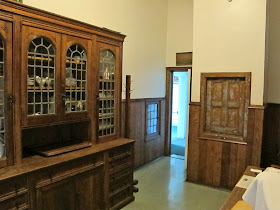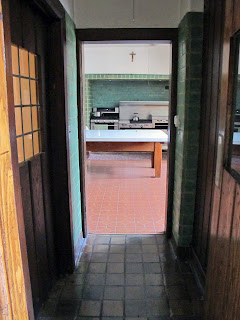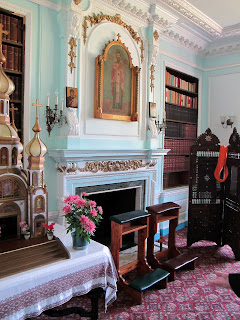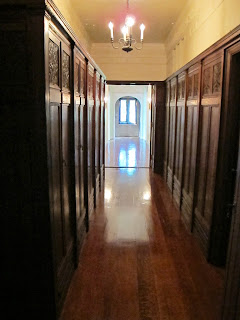
John E. Aldred (1864-1945) and his wife, Jane (d. 1948), are seen here in 1914 at Wheatley Hills, Long Island, probably at some swank horse event. Not many people have heard of Mr. Aldred, whose banking firm, Aldred & Co., financed an empire of public utilities. Aldred was a director of gas, water, power, and electric companies, and at one point chairman of the Gillette Safety Razor Co. At the time of this photo, he and an uber-prominent international lawyer named William D. Guthrie were putting together a Long Island real estate scheme.
Since the late 1660s, when local Indians had (no doubt unwittingly) sold land to one John Latting, there had been a small hamlet named Lattingtown located at the approximate intersection of today's Lattingtown Road and East Beach Lane. In 1915 Aldred and Guthrie bought and razed the entire village and replaced it with two magnificent estates. The Francophilic Guthrie called his Meudon, after a Paris suburb with a famous city view. Aldred called his Ormston, being his mother's maiden name. The image below shows the main gate to Ormston, or Ormston House as it is more grandly known, standing today in woods on the site of vanished Lattingtown. Like many great gates these days, it is closed, but not because there's nothing behind it.

In 1916, Mr. Aldred hired the fashionable architect Bertram Goodhue (1869-1924), seen below, to design his Long Island estate. Goodhue buildings have a reputation for ponderous magnificence, mostly of the Gothic Revival and Elizabethan Tudor persuasion. The partnership of Cram, Goodhue & Ferguson, established in 1898, gave us, among other things, St. Thomas on Fifth Ave. and 53rd St., and St. Bart's on Park and 51st. Interestingly, Goodhue finished his career out west, where he went off on a Spanish Colonial tack quite unlike his earlier work.

There's nothing Spanish Colonial about Ormston House, seen below in one of a remarkable series of Samuel Gottscho photos commissioned by the family, probably in the late 1920s. Gottscho ably captured a brooding magnificence, which is pretty much Ormston's overall tone.

Let me say from the outset that Ormston is still intact on 119 acres. However, there have been changes.

The Gottscho image below was taken on the other side of the entry court gate. Things to notice: ivy softening the stone facades; vines trained carefully on railings and balustrades; razor sharp lines between gravel and turf; carefully proportioned foundation plantings; and a specimen elm.

Here's the same view today, magnificent to be sure, but absent that millionaire's touch. Ormston sits atop an artificial hill constructed to improve the water view from the north facade. The lower door in this image leads to a south facing basement that is actually below grade on the other side of the house. Beyond the lower door is a stone hall that once was lined with suits of armor. The great rooms of the house, however, are on the floor above, so we're going to mount the exterior stairs and enter up there.

Since 1944, the Ormston estate has been a Ukrainian Orthodox monastery called St. Josaphats. A handful of novices lives and studies in the enormous former mansion, whose furniture was auctioned off in 1940, and labors mightily maintaining grounds that once required 35 full time gardeners. Talk about a labor of love. They are, as it happens, managing better than you might think.


The main floor entry hall is more scholarly than grand. It is a temptation among later owners of grand old houses to pick out in gold or bright colors certain raised elements in ornamental plaster work, which can be distracting.

Immediately to the right of the front door is Ormston's beating heart, the great hall. I don't know whether the paneling is antique, but Ormston is the sort of place you'd expect it.

Here's the great hall as Samuel Gottscho saw it in the '20s - not a place for intimate conversations, but rather one for large groups of guests waiting to go in to dinner. Nobody ever planned to sit for long in one of those chairs. P.S. If you've got big stone walls, it's a good idea to have big tapestries to cover them.


Here's the great hall today which, aside from the furniture, is totally intact.



A detail of wall and wood paneling on the door from the great hall to the dining room.

Gottscho's view of the dining room belies its actual scale.

Today it's still a dining hall, but for monks and novices instead of Long Island socialites. The pristine white of the ceiling emphasizes the rich luxury of the paneled walls. The silver safe, located behind a moveable wall panel, is actually an entire room that contains Goodhue's original floor plans.





This breakfast room would originally have been painted a pale monochrone.


This small pantry serviced both the breakfast room, glimpsed beyond the door in the distance, as well as the main dining room, behind us to the right. The dumb waiter would have sent food to the billiard room or Mr. Aldred's estate office on the floor below, or to bedrooms above.

The prep pantry and adjacent main kitchen are detailed with wonderful Arts and Crafts tiles and leaded glass cabinetry. See that black box between the doors in the second image?


It's the fire alarm, a sight easier to read and understand than one of those crazy "programmable" models you'd get today! Let's continue to the kitchen.


I love big kitchens in big old houses, and this is definitely one to love.



Here's our host, Father Leo, standing by the original walk-in, loving the kitchen as much as I do.

The service and staff areas of Ormston House are an enormous Chinese puzzle comprised of seemingly numberless corridors and rooms, some of whose original purposes are, frankly, hard to guess.



There are three staircases, two for the family and their guests, and one for the help. This is the service stair, located in the eastern wing. There's an elevator too, sited roughly in the middle of the house. Above the stair in the image below is a warren of servants' rooms. Below it is the laundry, where we're heading next. After that, Father Leo will guide us back to where we began.



We're back in the entry hall looking in the opposite direction from the great hall. Beyond the door in the image below is a corridor leading to a ladies' dressing room (the gents' is off the entry hall), a library with a no-longer-open view the Sound, and a drawing room that's been converted into a chapel.








Beyond Father Leo and my friend, Sam, is the corridor that leads back to the entry hall. If you can imagine thick rugs, damask upholstered sofas, antique chairs, polished wood tables, fringed lamp shades, gilt framed pictures on the walls and curtains with elaborate valances and big tasseled tiebacks on the windows, you'll have a sense of the original dignified luxury of this room.



Before going upstairs, we're detouring through that door on the far wall. Beyond it is a porch, a terrace and, before the trees grew up, a sweeping view of the Long Island Sound.





We'll head upstairs now to look at the master bedroom wing that sits atop the library and the drawing room.


At the top of the stairs, adjacent to a corridor leading to the master bedrooms, is John E. Aldred's study, whose identity I deduce from his initials over the door.


The corridor to the master bedrooms undergoes a midpoint transformation from Goodhue Elizabethan to Jane Aldred Parisian. Her bedroom was on my tour; her husband's, alas, was occupied and off limits. The Gottscho photo shows Mrs. A's as it used to be, and mine as it is today.






Mrs. Aldred's dressing room, now furnished with a bed, promised the glories of an adjacent ca. 1916 millionaire's bathroom. Sad to note, every single bathroom I saw had been stripped of vintage fixtures and wall treatments.


Mrs. Aldred's boudoir, pressed into modern service as a library, would seem a very unfeminine sort of room. However, its location next to her bedroom, the panorama in three directions of gardens, lawns and (originally) the Sound, plus her initials - JMA for Jane May Aldred - in plaster on the ceiling make it unlikely to have been anything else.





We're going to cross the stairhall now for a look at the principal guest corridor and a couple of guest rooms. This part of the house is located directly above the great hall.




We're back with Samuel Gottscho looking up the main stair. The door on the lower left goes to Mr. Aldred's study; the door beside it leads to the master bedrooms; I blush to admit that I can't remember if we explored that door on the top or not. In any case, from here we're heading down. Note how the stairs change from wood to stone as one approaches the armor hall and billiard room.



This is the sort of door that goes well with the suits of armor. Beyond it is the original snooker table, reportedly still here because it was too heavy to move.




The lower of the two doors to the courtyard is behind us; the entrance to the billiard room is at the foot of the stairs; radiating from the threshold on which we stand are corridors extending east and west to a myriad of service and supply rooms.




Sam and Father Leo are ignoring the 800-lb gorilla in Mr. Aldred's house office. A separate entrance for non-social visitors connects this room to a point just outside the entry court gates.

This room used to be full of coal. It has been optimistically converted into an exercise room for novices who are far too busy hauling, climbing, hefting, not to mention studying and praying, to spend much time with barbells.

And this room is for....moose heads and platitudes.

This sign on the tradesmen's entrance has been in the same glass frame for almost a century. Beyond it is the service court, flanked on the east by the laundry and servants' quarters.


There is a second family staircase, located more or less in the center of the house, accessing a great many additional bedrooms distributed among a dizzying number of levels.



One of these belonged to the charming little girl whose portrait below once hung at Ormston. Jane May Aldred (same name as her mother) was her parents' only child. She lived in the bedroom below when she was small.







Does there seem any end to Ormston's multiplicity of corridors and purpose built service rooms? That would be a "no."


Just so you know where you've been, from left to right in the image below: 1) Above the porch on the far left is Mrs. A's boudoir; 2) The stacked bay windows are in her bedroom (top) and the drawing room (bottom); 3) The oriel window over the main level front door is Mr. A's study; 4) The big tall windows are the great hall; 5) The tall bay widow on the jutting wing is the breakfast room, with family bedrooms above; and 6) The tall chimney on the far right sits on top of the eastern service wing. The balustrade overlooks the entry court below and extends south towards formal gardens.


A view of the gardens as they were, and as they are today.


Gottscho snapped this vintage view from the entry court, his back to the house. See the distant statue? The modern view looks down the garden in the opposite direction from behind it.


Other garden views, one with yours truly.



The rose garden, as it was and as it is.


Ormston still has two gatehouses, both in seemingly perfect condition and both rented to longterm tenants. There is also a vintage caretaker's building, seemingly in good repair, a sadly deteriorated greenhouse complex and an underused stable of the sort modern estate subdividers would kill for. Back in the 1980s St. Josephat's erected a combination library and residence building which, had it not already been obscured by trees, would be in the middle of the water view from the house.


Until 1931, Lattingtown was an unincorporated part of the Town of Oyster Bay. Circling the wagons in that dark Depression year, its plutocratic population incorporated their three square miles, elected W.D. Guthrie mayor and belatedly joined what the New York Times called the "Millionaire Villages." It was at best a desperate affirmation of a crumbling status quo. When Guthrie died in 1935, Aldred took over his unexpired term. He was elected himself in 1936, notwithstanding which, within four short years, Ormston was stripped bare by the auctioneer, Aldred and his wife moved to the Garden City Hotel, and title to his former Long Island showplace passed to an Aldred-owned company called Baltimore Light and Power. It's debatable to what extent economics played a role in the abandonment of Ormston. Aldred was still a rich man, but he was also in his late seventies, had no family who wanted the place, and was likely tired of the enormous energy required to keep it running. The year before he died, B L & P sold it to the Ukrainians for $75,000. Guthrie's Meudon fared much worse; it was demolished in 1955. To My Readers: The "Secret World" originally appeared here last July, but for several reasons I'm posting it again - a sort of encore presentation. With luck you won't have seen it, and will enjoy reading it now as much as I enjoyed writing it then. I'll be back next week with a totally new old house....JF

Thank you! Your posts just keeping getting more detailed and more interesting. How do you find the time?
ReplyDeleteRegarding Ormston, didn't Audrey Hepburn live here in "Sabrina" (1954)? LOL. Clearly, this was the sort of estate that inspired all those fictional "Long Island Rich" movie settings. It's beautiful and enormous! What a lovely private world it must have been.
The 19th Century author and art critic Clarence Cook criticized the American tendency to build oversized houses, calling them "today's pride & joy, tomorrow's White Elephant". Sadly, that seems true of this place, although the Alfreds must have loved it while they had it. And, clearly, the monks appreciate it now.
I have always been intrigued as to what this place looked like now! Thank you so much for such a detailed and entertaining tour! LOVING your excursions and pics! Keep em coming!!
ReplyDeleteThanks for the extensive tour. I remember when there was an annual fair held on the estate and you could wander about the grounds and were given a tour of the first floor of the house. In your photos I missed seeing the small teahouse modelled after Monacuete House in the UK. I also remember the huge walled garden with a viewing tower at one corner.
ReplyDeleteYour posts do keep getting better and better. Ormston appears to be very well taken care of by the members of the monastery and it is truly a spectacular mansion. The formal gardens and both sets of gatehouses and gates are some of the best examples surviving on Long Island. I believe there is still a Sunday service given in the mansion if anyone is interested in joining. fantasic peek at a little known mansion hidden behind the walls in Lattingtown.
ReplyDeleteNever a problem repeating a post if it is as wonderful as this one. Ormston is a treasure and should be preserved. Hopefully it will remain intact for future generations to admire.
ReplyDeleteBeen following your blog for some months now - love it. Informed and informative and I enjoy the writing. "Handful of novices" - singular. Grammatically precise for these days!
ReplyDeleteAnyway, had to drop a line. "Moose head and platitude room" - delightful. The victorians, of course, were renowned for their multiplicity of dedicated service rooms. Doubt we have many if those in the UK though!
I lived in one of the Ormston House gatehouses when I was a kid. I went back there today and tried to hunt down Father Leo, but no one was home! Thanks for the wonderful pictures.
ReplyDeleteI found lots of interesting information here. The post was professionally written and I feel like the author has extensive knowledge in the subject. Keep it that way this is very good to see.
ReplyDeleteFiberglass columns
A foyer or an entryway is the first area that your guests will notice as they step into your home. So, it is imperative that you decorate it tastefully.
ReplyDeleteinterior designer arizona
The tall chimney on the far right sits on top of the eastern service wing. The balustrade overlooks the entry court below and extends south towards formal gardens. Thank you
ReplyDeleteFactor Quema Grasa
ReplyDeleteFactor Quema Grasa Pdf
Libro Factor Quema Grasa
Factor Quema Grasa Gratis
Factor Quema Grasa Descargar
Factor Quema Grasa Descargar Gratis
Factor Quema Grasa Libro
Factor Quema Grasa Libro Gratis
Factor Quema Grasa Pdf Gratis
Libro Factor Quema Grasa Pdf
How did the fire in February affect the main structure of the mansion? Please do an update!
ReplyDeleteI just discovered this wonderful place while hiking along Pryibil Beach . Thanks for the tour ! Is there any way for the general public to gain access?
ReplyDeleteMy uncle Fr. Jerome Barnych was a young priest at St. Josephat's in the 1950's. St. Josephat's has always been a very special place for my family and we spent a great deal of time there as I was growing up. This article was well written. I truly enjoyed the more historic photos as they pre - date early family counterparts. I am very blessed to have been able to spend such quality time there.
ReplyDeleteAnd very special thanks to the great volunteer gardening every weekend of Stephen. He is being truly blessed.
ReplyDeleteAny help is always accepted.
Your blog reads like a wonderful mystery novel, I appreciate the time and detail in each entry. I am coming back...over and over again! Best Wishes in your RE adventures, thanks for sharing them with us. GT
ReplyDeleteSilver Gold Bull is a highly trusted bullion dealer. They will provide you with competitive, up-to-minute pricing and make sure that your precious metals arrives to your door discreetly and fully insured.
ReplyDeleteThank you for the blog - the photos are terrific and I well enjoy seeing the comparison from yester-year to current. As a relative to Fr. Jerome Barnych - one of the early priests of St. Josaphat's. I appreciate all the work for this blog; however, I must add a correction. St. Josaphat's is not an Orthodox Monastery - It's Ukranian Catholic.
ReplyDeleteMy mother remembers the gate house. As a teen in the late 1940's, she and her friends would pass on the road by the gatehouse on the way to East Beach. She remembers the monks swimming in the sound.
ReplyDelete